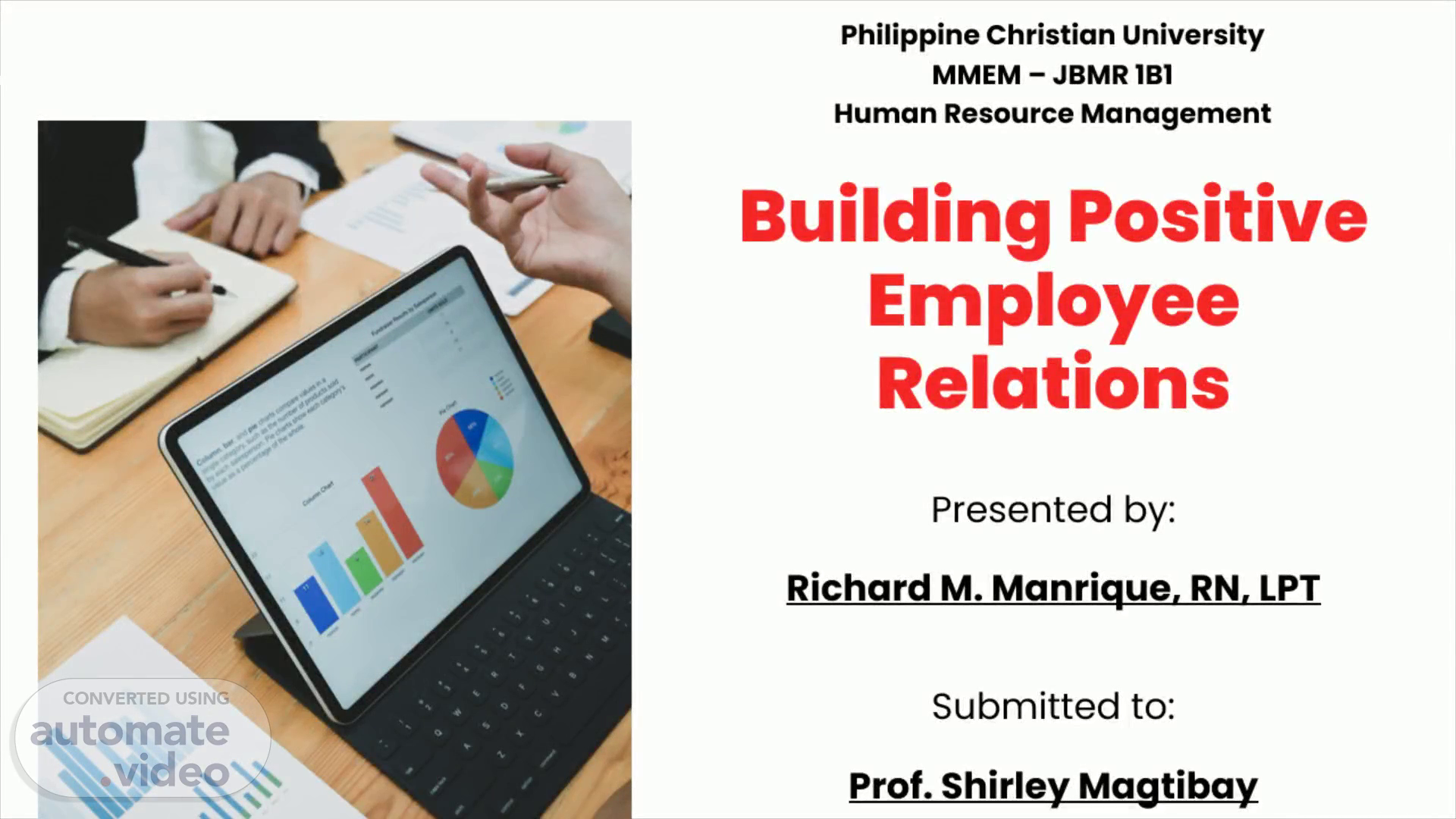
PowerPoint Presentation
Scene 1 (0s)
[Audio] Good day, Im Richard M. Manrique, your reporter for this session..
Scene 2 (12s)
What is Employee Relations?. I s the activity that involves establishing and maintaining the positive employee-employer relationships that contribute to satisfactory productivity, motivation, morale, and discipline, and to maintaining a positive, productive, and cohesive work environment..
Scene 3 (26s)
Employers can do many things to build positive employee relations..
Scene 4 (45s)
How to ensure fair treatment. Ensuring Fair Treatment Anyone who has suffered unfair treatment at work knows it is demoralizing. Unfair treatment reduces morale, poisons trust, and negatively impacts employee relations and performance. Employees of abusive supervisors are more likely to quit, and to report lower job and life satisfaction and higher stress. The effects on employees of such abusiveness are particularly pronounced where the abusive supervisors seem to have support from higher-ups. At work, fair treatment reflects concrete actions such as “employees are treated with respect,” and “employees are treated fairly.”.
Scene 5 (1m 12s)
Reasons for fair treatment.. Unfairness can backfire on the company. For example, victims of unfairness exhibit more workplace deviance, such as theft and sabotage. Victims of unfairness also suffer a range of ill effects including poor health, strain, and psychological conditions. Unfairness leads to increased tensions between the employee and his or her family or partner. Abusive supervisors undermine their subordinates’ effectiveness and may prompt them to act destructively..
Scene 6 (1m 33s)
Reasons for fair treatment.. In terms of employee relations, employees’ perceptions of fairness relate positively to enhanced employee commitment; enhanced satisfaction with the company, job, and leader; and enhanced organizational citizenship behaviors. The employer and the manager are responsible for ensuring that the employee is treated fairly and with respect (and that its employees treat each other respectfully)..
Scene 7 (1m 51s)
Bullying and Victimization. BULLYING INVOLVES THREE THINGS: Imbalance of power . People who bully use their power to control or harm, and the people being bullied may have a hard time defending themselves. Intent to cause harm . Actions done by accident are not bullying; the person bullying has a goal to cause harm. Repetition . Incidents of bullying happen to the same person over and over by the same person or group..
Scene 8 (2m 11s)
Bullying and Victimization. BULLYING CAN TAKE MANY FORMS, SUCH AS: Verbal: name-calling, teasing Social: spreading rumors, leaving people out on purpose, breaking up friendships Physical: hitting, punching, shoving Cyberbullying: using the Internet, mobile phones, or other digital technologies to harm others.
Scene 9 (2m 27s)
Improving Employee Relations through Communication.
Scene 10 (2m 50s)
Develop Employee Recognition / Relations Programs.
Scene 11 (3m 16s)
Use Employee Involvement Programs. Employers encourage employee involvement in various ways. Some organize focus groups. A focus group is a small sample of employees who are presented with a specific question or issue and who interactively express their opinions and attitudes on that issue with the group’s assigned facilitator..
Scene 12 (3m 31s)
Ethics and Employee Rights. Protecting employee rights is thus part and parcel of all the employment laws. Although ethics, fairness, and morality help govern how employers treat their employees, the enforceable rights embedded in employment law also govern what employers and employees can do..
Scene 13 (3m 47s)
How Managers Can Create More Ethical Environments.
Scene 14 (4m 3s)
How Human Resource Managers Can Create More Ethical Environments.
Scene 15 (4m 28s)
How Human Resource Managers Can Create More Ethical Environments.
Scene 16 (5m 2s)
How Human Resource Managers Can Create More Ethical Environments.
Scene 17 (5m 39s)
Managing Employee Discipline. The purpose of discipline is to encourage employees to behave sensibly at work . Discipline is necessary when an employee violates a rule. Proper disciplinary procedures are important for several reasons. For one thing, positive employee relations require trust, and few personnel actions will undermine trust as will arbitrarily discipline. Legal concerns are another reason..
Scene 18 (5m 57s)
Managing Employee Discipline. The Three Pillars of Fair Discipline Rules And Regulations – An acceptable disciplinary process begins with a set of clear disciplinary rules and regulations. The rules should cover problems such as theft, destruction of company property, drinking on the job, and insubordination. Penalties – A system of progressive penalties is the second pillar of effective discipline. The severity of the penalty usually depends on the offense and the number of times it has occurred. Appeals Process – Third, an appeals process should be part of the disciplinary process. The aim here is to ensure that supervisors mete out discipline fairly. An appeals process is essential but is no panacea. The employer can sometimes mitigate the effects of unfair discipline by catching it during an appeal. However, some supervisory behavior may be impossible to overcome..
Scene 19 (6m 31s)
Discipline without Punishment. Traditional discipline processes have two main drawbacks: First, no one likes being punished. Second, punishment tends to gain short-term compliance, but not long-term cooperation. Discipline without punishment (or alternative or non punitive discipline) aims to avoid these drawbacks by reducing the punitive nature of the discipline..
Scene 20 (6m 48s)
Discipline without Punishment. Steps include the following: Issue an oral reminder for a first infraction . Should another incident arise within 6 weeks, issue a formal written reminder, and place a copy in the employee’s personnel file. Also, hold a second private discussion with the employee. Give a paid, one-day “decision-making leave.” If another incident occurs in the next 6 weeks or so, tell the employee to take a 1-day leave with pay, and to consider whether he or she wants to abide by the company’s rules. When the employee returns to work, he or she meets with you and gives you a decision. If no further incidents occur in the next year or so, purge suspension from the person’s file. If the behavior is repeated, the next step is dismissal. the 1-day paid.
Scene 21 (7m 23s)
THANK YOU.. Building Positive Employee Relations.